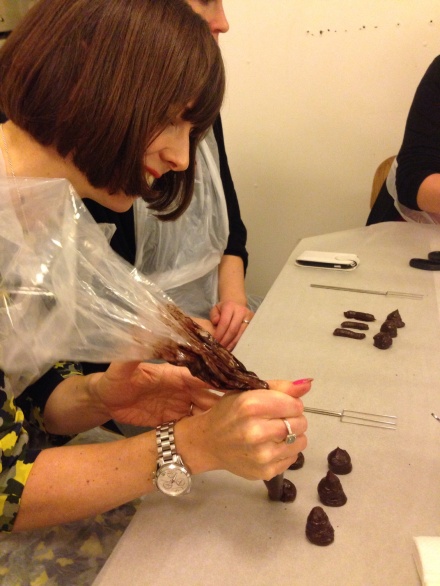I have sadly come to the realisation that there is not, nor ever will be, a glittering career as a chocolatier ahead of me. For one, it’s tricky stuff. You only have to watch an episode of The Great British Bake Off to see how quickly making ganache or tempering chocolate can turn into a car crash. Use a chocolate with too low cocoa solids, you end up with a ganache that won’t. bloody. set., or use large amounts of the extra dark stuff and you might end up with something so insomnia-inducing that it leaves you wired for days. Like most people, I absolutely love chocolate in all its forms, so when the opportunity to learn more about it arose, I jumped at the chance, hoping that I might become somebody who effortlessly turns out beautiful confectionery without ruining their clothes and kitchen worktops in the process. Not quite, but they tried.
I was invited to take part in a truffle-making session with MyChocolate, a company that organises chocolate-making workshops for groups. Run by chocolatier Hannah Saxton, the school employs a number of staff and teachers who seek to deliver a range of events for corporate teams, hen parties, stag parties and birthdays; all around the process of making and tasting chocolate, as well as forays into the worlds of cupcakes and cocktails. They operate events out of venues in London, Brighton and Manchester, but have recently developed a mobile workshop, so can put on classes in other parts of the country when needed.
This class was run from their main kitchen in central London, close to Farringdon station. Once we were seated in groups at large tables full of chocolate-making paraphernalia, had out aprons on and a glass of prosecco in hand, we were ready to begin.
The first part of the course focuses around learning to understand and taste chocolate. The first task was to blind taste two pieces of chocolate and decide which is the good-quality organic stuff, and which was cheap supermarket chocolate. Everybody in the class guessed correctly, but I was surprised to see that several of my fellow bloggers preferred the cheaper chocolate to the good stuff. I myself am partial to the odd bar of Dairy Milk, but it really was no contest. We were then given three pieces of chocolate with varying percentages of cocoa solids to taste. The amount of cocoa solids in chocolate gives it many of its characteristics, including how quickly it will set when made into a ganache, which is the basis for truffles.
The traditional method of making truffles is to make a ganache by heating cream to scorching point, removing it from the heat and stirring in chopped chocolate until smooth. This is then set in the fridge for several hours until firm and spoonfuls of ganache scooped out and rolled into balls. As the workshops lack the luxury of such time, ganache is made by pouring cold cream into melted chocolate and rapidly stirring until it sets. Charlotte, our teacher for the evening, showed us how to do this before demonstrating a method of piping out the soft ganache on to parchment and letting them set in their shapes. If you don’t want to end up with completely brown hands, a la the rolling method, this could be for you. Once set, the truffles are dipped into bowls of melted milk or dark chocolate and either rolled in cocoa powder or decorated.
Unfortunately, my chocolate-making skills were still not of a high standard, and I still managed to end up with more on my face and in my hair than I had hoped, but my technique improved somewhat under Charlotte’s guidance. The truffles I made were, let’s face it, never going to be of the kind you might find in a little Belgian-chocolate shop, but they looked like less of a mess than I feared they may, even after I went crazy with the freeze-dried raspberries. Several hours later, drinking G&Ts in The Actress, they tasted rather good.
My Chocolate, Unit B1 Hatton Square Business Centre, 16-16a Baldwins Gardens, London EC1N 7RJ @MyChocolateUK
I was invited to review MyChocolate









